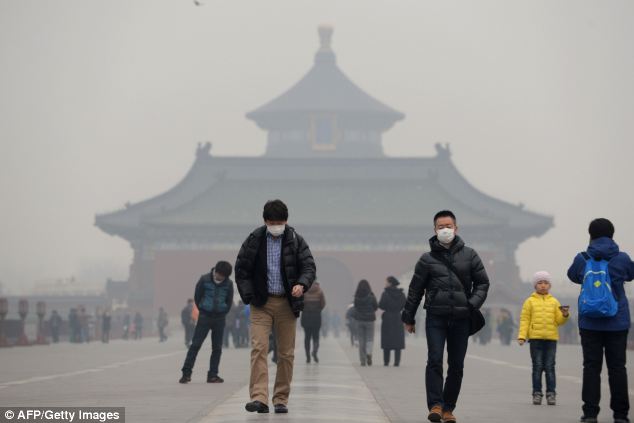Sunday Times 2
Asian pollution causing ‘dramatic’ strengthening of storms in North America, say NASA scientists
Air pollution in China and other Asian countries is causing storms in North America to become stronger and changing weather patterns across the Northern Hemisphere, a new Nasa study has claimed.
Researchers found that pollutants are strengthening storms above the Pacific Ocean, which feeds into weather systems in other parts of the world.
The effect was most pronounced during the winter, the team said

The Temple of Heaven in haze-covered Beijing
Lead author Yuan Wang, from the Jet Propulsion Laboratory at the California Institute of Technology, said: ‘There appears to be little doubt that these particles from Asia affect storms sweeping across the Pacific and subsequently the weather patterns in North America and the rest of the world.
‘The effects are quite dramatic. ‘The pollution results in thicker and taller clouds and heavier precipitation.’
Northwest Pacific winter storms are now 10 percent stronger than they were 30 years ago, the team said.
The study is published in the Proceedings of the National Academy of Sciences.
In the first study of its kind, scientists compared air pollution rates from 1850 to 2000 and found that anthropogenic (man-made) particles from Asia impact the Pacific storm track that can influence weather over much of the world
The team used detailed pollution emission data compiled by the Inter-governmental Panel on Climate Change and looked at two scenarios: one for a rate in 1850 – the pre-Industrial era – and from 2000, termed present-day.
By comparing the results from an advanced global climate model, the team found that anthropogenic aerosols conclusively impact cloud formations and mid-latitude cyclones associated with the Pacific storm track.
‘The climate model is quite clear on this point,’ said Wang.
‘The aerosols formed by human activities from fast-growing Asian economies do impact storm formation and global air circulation downstream.
‘They tend to make storms deeper and stronger and more intense, and these storms also have more precipitation in them. ‘We believe this is the first time that a study has provided such a global perspective.’
In addition, Zhang says large amounts of aerosols and their long-term transport from Asia across the Pacific can clearly be seen by satellite images.
The Pacific storm track represents a critical driver in the general global circulation by transporting heat and moisture, the team notes.
The transfer of heat and moisture appears to be increased over the storm track downstream, meaning that the Pacific storm track is intensified because of the Asian air pollution outflow.
‘Our results support previous findings that show that particles in the air over Asia tend to affect global weather patterns,’ Zhang adds.
‘It shows they can affect the Earth’s weather significantly.’
© Daily Mail, London

